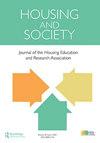Trauma-informed design for permanent supportive housing: four case studies from Seattle and Denver
Q2 Social Sciences
引用次数: 5
Abstract
Abstract Single-site, permanent supportive housing (PSH) buildings with a Housing First approach have become an increasingly common solution to homelessness in many North American cities. Because people who have experienced long-term homelessness are also likely to have experienced trauma, trauma-informed care has become a key tenet of service providers working with residents in PSH. Trauma-informed design (TID), however, is newer. Relatively little research or theory exists about its implementation in PSH. This paper explores recently constructed, single-site, Housing First PSH buildings in the United States to understand how trauma-informed design principles are manifest in the common areas of those buildings. Data for the study consisted of interviews with social service providers, observations of the TID spaces, and photographs and floor plans of the buildings, and, for three buildings, minutes from the TID process meetings. The analysis revealed four approaches to trauma-informed PSH: 1) provide multiple common areas to maximize resident choice and safety; 2) separate spaces with walls but connect them with interior windows to provide safety; 3) supply a central third stair to encourage social engagement and 4) design places for future resident empowerment and voice. This research contributes a necessary, heretofore missing, spatialization to existing scholarship on PSH.永久性支持性住房的创伤性设计:来自西雅图和丹佛的四个案例研究
在许多北美城市中,采用住房优先方法的单站点永久性支持性住房(PSH)建筑已成为解决无家可归问题的日益普遍的解决方案。由于长期无家可归的人也可能经历过创伤,创伤知情护理已成为服务提供者与PSH居民合作的关键原则。然而,创伤知情设计(TID)是一种较新的设计。关于其在PSH中的实施的研究或理论相对较少。本文探讨了最近在美国建造的单场地住房优先PSH建筑,以了解创伤知情设计原则如何在这些建筑的公共区域体现出来。该研究的数据包括对社会服务提供者的访谈、对TID空间的观察、建筑物的照片和平面图,以及三座建筑物的TID流程会议记录。分析揭示了创伤知情PSH的四种方法:1)提供多个公共区域,以最大限度地提高居民的选择和安全性;2)用墙分隔空间,但用室内窗户连接,以提供安全;3)在中央设置第三层楼梯,鼓励社会参与;4)为未来的居民赋权和发声设计场所。这项研究为PSH的现有学术研究提供了一个必要的、迄今为止缺失的空间化。
本文章由计算机程序翻译,如有差异,请以英文原文为准。
求助全文
约1分钟内获得全文
求助全文
来源期刊

Housing and Society
Social Sciences-Urban Studies
CiteScore
2.30
自引率
0.00%
发文量
10
期刊介绍:
Housing and Society is the journal of the Housing Education and Research Association (HERA). The journal supports the mission of HERA by providing for the dissemination of research and other scholarly work. Submissions from a broad range of perspectives are encouraged. Topics in housing include: policy, design, social aspects, gerontology, behavioral aspects, energy/environment, equipment, interiors, economics, theory/model development, education, and program development or evaluation. The journal welcomes the submission of original research articles, notes and commentaries. Notes are shorter manuscripts presenting succinct information on housing related to one of the following categories: - Research: exploratory or not heavily theory-based or statistically analyzed - Academic: innovative teaching ideas - Program: development, implementation, and/or evaluation of Cooperative Extension or other housing programming efforts - Policy: examination of policy impact, comparative analysis, and/or need to achieve housing goals - Reviews: books, documentaries, etc.
 求助内容:
求助内容: 应助结果提醒方式:
应助结果提醒方式:


